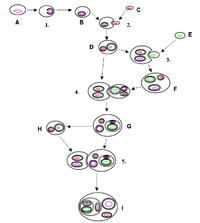
Photo from wikipedia
Insects with restricted diets rely on obligate microbes to fulfil nutritional requirements essential for biological function. Tsetse flies, vectors of African trypanosome parasites, feed exclusively on vertebrate blood and harbour… Click to show full abstract
Insects with restricted diets rely on obligate microbes to fulfil nutritional requirements essential for biological function. Tsetse flies, vectors of African trypanosome parasites, feed exclusively on vertebrate blood and harbour the obligate endosymbiont Wigglesworthia glossinidia. Without Wigglesworthia, tsetse are unable to reproduce. These symbionts are sheltered within specialized cells (bacteriocytes) that form the midgut-associated bacteriome organ. To decipher the core functions of this symbiosis essential for tsetse's survival, we performed dual-RNA-seq analysis of the bacteriome, coupled with metabolomic analysis of bacteriome and haemolymph collected from normal and symbiont-cured (sterile) females. Bacteriocytes produce immune regulatory peptidoglycan recognition protein (pgrp-lb) that protects Wigglesworthia, and a multivitamin transporter (smvt) that can aid in nutrient dissemination. Wigglesworthia overexpress a molecular chaperone (GroEL) to augment their translational/transport machinery and biosynthesize an abundance of B vitamins (specifically B1-, B2-, B3- and B6-associated metabolites) to supplement the host's nutritionally deficient diet. The absence of Wigglesworthia's contributions disrupts multiple metabolic pathways impacting carbohydrate and amino acid metabolism. These disruptions affect the dependent downstream processes of nucleotide biosynthesis and metabolism and biosynthesis of S-adenosyl methionine (SAM), an essential cofactor. This holistic fundamental knowledge of the symbiotic dialogue highlights new biological targets for the development of innovative vector control methods.
Journal Title: Proceedings of the Royal Society B: Biological Sciences
Year Published: 2017
Link to full text (if available)
Share on Social Media: Sign Up to like & get
recommendations!